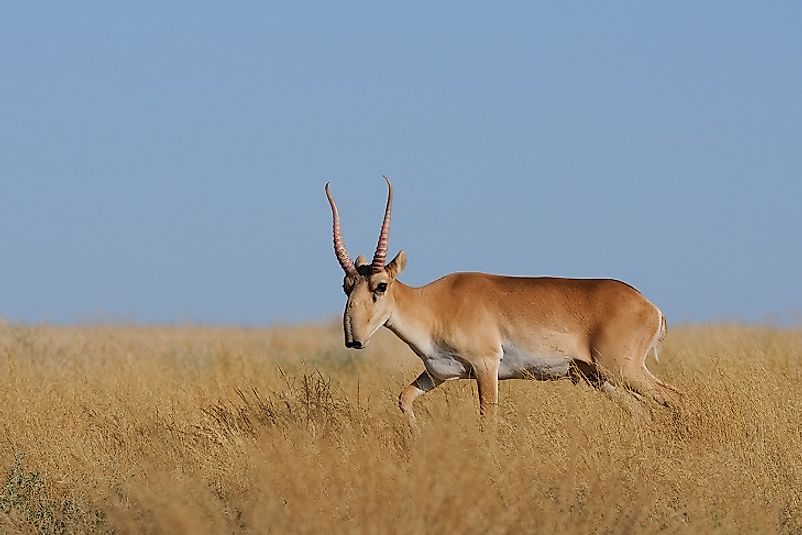Endangered Mammals Of Kazakhstan

There are a variety of different endangered mammals that are either unique to Kazakhstan alone or that live in Kazakhstan and the various countries surrounding it in the Central Asian region. This article will discuss in depth only a small handful of these mammals, their physical characteristics, habitats, dietary patterns and more. It will also discuss there current status of why and when they were made endangered species.
Endangered Mammals of Kazakhstan
Argali
The Argali, scientific name Ovis ammon, is a species of wild sheep that has nine currently recognized subspecies. The species can grow to be anywhere from 4 to 6.6 feet (121 to 201 centimeters) in length and 3 to 4 feet (91 to 121 centimeters) in height, while also weighing anywhere from 130 to 350 pounds (59 to 158 kilograms). The argali is also supposed to be the largest of all wild sheep species. The species varies in look from having light yellow fur to having dark grey-brown colored fur, although their faces are light in color then the rest of their body. The males and females are differentiated by the males having a whitish colored neck ruff, a dorsal crest and two corkscrew horns that can grow up to 6.3 feet (192 centimeters), while the females have horns that are much smaller with no neck ruff or doral crest. They are herbivores, mainly eating on grass and herbs. The species remains in single sex herds until mating season. Females take around 155 days to give birth to either one or two young ones. The argali live at high elevations above 1,000 meters (3,280 feet) and are found in many different countries, including Kazakhstan, Russia, Nepal, China and others. The species put on the endangered list in 1976 and are mostly threatened by having to compete with domestic sheep for food and living space, as well as from hunters who take their horns and meat.
Saiga Antelope
The Saiga Antelope, scientific name Saiga tatarica, is a species of antelope. The species generally grows to be anywhere from 3.8 to 4.8 feet (115 to 146 centimeters) in length, is around 2.5 feet tall (76 centimeters) and usually weights around 112 pounds (50 kilograms). The species is unique looking with its short, round bodies, skinny legs, short tail and is most noted for its large, humped nose that looks inflatable. Depending on the season they will have shorter and lighter fur coats for summer and thicker and darker fur coats during winter. The saiga antelope is also noted for its running speed, as it can reach speeds as fast as 80 miles per hour. They are herbivores that eat many different types of herbs, shrubs and grasses. Females in the species take around 140 days to give birth to either one or two offspring. The species is migratory and is usually found in wither grasslands or semi-desert steppes of Kazakhstan, Turkmenistan, Mongolia, Uzbekistan and Russia. The species was put on the endangered list in 2009 and it is mainly threatened by loss of its habitat, being over-hunted for there horns, disease, drought and being disturbed by humans.
Snow Leopard
The Snow Leopard, scientific name Uncia uncia, is a species of big cat. The snow leopard can grown to be up to 4 feet (121 centimeters) long and can weight anywhere from 60 to 120 pounds (27 to 54 kilograms). The species has spotted fur that comes in a variety of colors from white to cream to grey to yellow, with a tail that has thick fur and can grow to be up to 4 feet long. The species is extremely muscular and agile and is noted for its incredible jumping ability, they can jump up to 20 feet (609 centimeters) vertically and 50 feet (1,524 centimeters) horizontally. The snow leopard are carnivores and eat boars, arkhar, ibex and a variety of small rodent species. The females in the species take around 100 days to give birth, usually having two or three cubs. They live in mountain steppes or coniferous forest at a high altitude of 2,000 to 6,000 meters (6,561 to 19,685 feet) in Central Asia. The species was put on the endangered list in 1972 and its biggest threats are being hunted for its pelts, bones and other body parts, the loss its native habitats and having to compete with humans for food. Conservation efforts and bedding in captivity have helped the species as the current population is up to around 6000, which is 5000 greater then it was in the 1960s.
What Can We Do To Save These Endangered Species?
There are many different actions that can be taken by individuals and organizations to help protect these endangered mammal species of Kazakhstan. One way could be to donate money to a local or national organization or wildlife refuge in Kazakhstan that works to protect, monitor, and breed these endangered species. These are also international organizations that one could look into working for or even donating money to whose goal is to protect these endangered species. People living in Kazakhstan and other countries where these animals live can also try and push their elected officials to support protecting these endangered species and getting them to support environmental friendly legislation.
Endangered Mammals Of Kazakhstan
| Endangered Mammals of Kazakhstan | Binomial Scientific Name |
|---|---|
| Saiga Antelope | Saiga tatarica |
| Iranian (Asiatic) Cheetah | Acinonyx jubatus venaticus |
| Desert Dormouse | Selevinia betpakdalaensis |
| Snow Leopard | Uncia uncia |
| Tien Shan Dhole | Cuon alpinus hesperius |
| European Mink | Mustela lutreola |
| Przewalski's Horse | Equus ferus przewalskii |
| Five-Toed Pygmy Jerboa Pond Bat Geoffroy's Bat Argali | Cardiocranius paradoxus Myotis dasycneme Myotis emarginatus Ovis ammon |
| Thick-Tailed Pygmy Jerboa Russian Desman Caspian Seal | Salpingotus crassicauda Desmana moschata Pusa caspica |
| Giant Mole-Rat Steppe Pika Goitered Gazelle | Spalax giganteus Ochotona pusilla Gazella subgutturosa |







